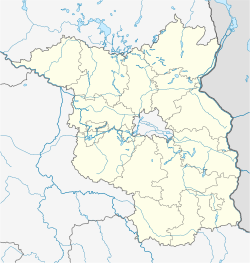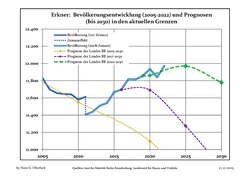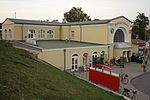
Frankfurt (Oder), also known as Frankfurt an der Oder (German:[ˈfʁaŋkfʊʁtʔandeːɐ̯ˈʔoːdɐ], lit. 'Frankfurt on the Oder'; Central Marchian: Frankfort an de Oder, Polish: Frankfurt nad Odrą) is the fourth-largest city in the German state of Brandenburg after Potsdam, Cottbus and Brandenburg an der Havel. With around 58,000 inhabitants, it is the largest German city on the Oder River, and one of the easternmost cities in Germany. Frankfurt sits on the western bank of the Oder, opposite the Polish town of Słubice, which was a part of Frankfurt until 1945, and called Dammvorstadt until then. The city is about 80 kilometres (50 mi) east of Berlin, in the south of the historical region Lubusz Land. Within Frankfurt's city limits lies the recreational area Lake Helenesee.
Märkisch-Oderland is a Landkreis (district) in the eastern part of Brandenburg, Germany. Neighboring this district are the district of Barnim, the country of Poland, the district-free city of Frankfurt (Oder), the district of Oder-Spree and the Bundesland of Berlin. The administrative seat is the town of Seelow but the largest town is Strausberg.
Oder-Spree is a Kreis (district) in the eastern part of Brandenburg, Germany. Neighboring are the district Märkisch-Oderland, the district-free city Frankfurt (Oder), Poland, the districts Spree-Neiße and Dahme-Spreewald, and the Bundesland Berlin.

Eberswalde is a major town and the administrative seat of the district Barnim in Brandenburg in north-eastern Germany, about 50 km (31 mi) northeast of Berlin. Population 42,144, geographical location 52°50′N13°50′E. The town is often called Waldstadt, because of the large forests around it, including the Schorfheide-Chorin Biosphere Reserve. Despite this fact, Eberswalde was an important industrial center until the German Reunification.

Fürstenwalde/Spree is the most populous town in the Oder-Spree District of Brandenburg, in eastern Germany.

Rüdersdorf is a municipality in the district Märkisch-Oderland, in Brandenburg, Germany, near Berlin.

Schöneiche is a municipality in the Oder-Spree District of Brandenburg, Germany. It is situated directly at the edge to Berlin/Friedrichshagen and next to Rüdersdorf and Woltersdorf, Brandenburg on the eastern edge of the German capital Berlin.

Beeskow is a town in Brandenburg, in eastern Germany, and capital of the Oder-Spree district. It is situated on the river Spree, 30 km southwest of Frankfurt an der Oder.

Friedland is a town in the Oder-Spree district, in Brandenburg, Germany. It is situated in the historic Lower Lusatia region, about 8 km (5.0 mi) south of Beeskow, and 39 km (24 mi) north of Cottbus.

Storkow (Mark) is a town in Oder-Spree district, in Brandenburg, Germany. The town was the part of Brandenberg Province of Prussia, from 1815 - 1947, then it was the part of the State of Brandenburg from 1947 to 1952, Bezirk Frankfurt of East Germany from 1952 to 1990 and it again became a part of the State of Brandenburg since 1990.

Woltersdorf is a municipality in the Oder-Spree district in Brandenburg. It is often referred to as "near Berlin" or "near Erkner" as there are a number of other places bearing the same name in Germany.

Gosen-Neu Zittau is a municipality in the Oder-Spree district, in Brandenburg, Germany. Neu Zittau is situated in the Spree valley, near the Oder-Spree-Canal.

Grünheide (Mark) is a municipality in the Oder-Spree District, in Brandenburg, Germany. It is situated 30 kilometres south-east of Berlin city centre, on the River Löcknitz. In 2020 Tesla, Inc. began to build Gigafactory Berlin-Brandenburg in Grünheide near the Autobahn A10.

Rietz-Neuendorf is a municipality in the Oder-Spree district, in Brandenburg, Germany

Steinhöfel is a municipality in the Oder-Spree district, in Brandenburg, Germany. Since the beginning of 2019 it belongs to the collective municipality "Amt Odervorland"
Amt Spreenhagen is an Amt in the district of Oder-Spree, in Brandenburg, Germany. Its seat is in Spreenhagen.
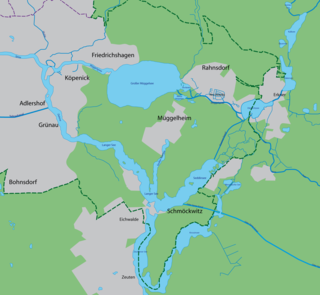
The Dämeritzsee is a lake located in Brandenburg and Berlin, Germany. At an elevation of 32 metres (105 ft), its surface area is 93.5 hectares. It is located partly in the municipality of Erkner and part in Rahnsdorf, a Berliner locality in Treptow-Köpenick district.

Eisenhüttenstadt is a town in the Oder-Spree district of the state of Brandenburg, in eastern Germany, on the border with Poland. East Germany founded the city in 1950. It was known as Stalinstadt (Stalinměsto) between 1953 and 1961.

Rahnsdorf is a locality (Ortsteil) of Berlin, Germany, located in the southeast of the Berlin borough (Bezirk) of Treptow-Köpenick. Until 2001 it was part of the former borough of Köpenick.
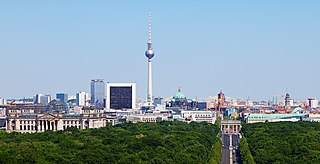
The Berlin/Brandenburg metropolitan region or capital region is one of eleven metropolitan regions of Germany, consisting of the entire territories of the state of Berlin and the surrounding state of Brandenburg. The region covers an area of 30,545 square kilometres (11,793 sq mi) with a total population of about 6.2 million.



